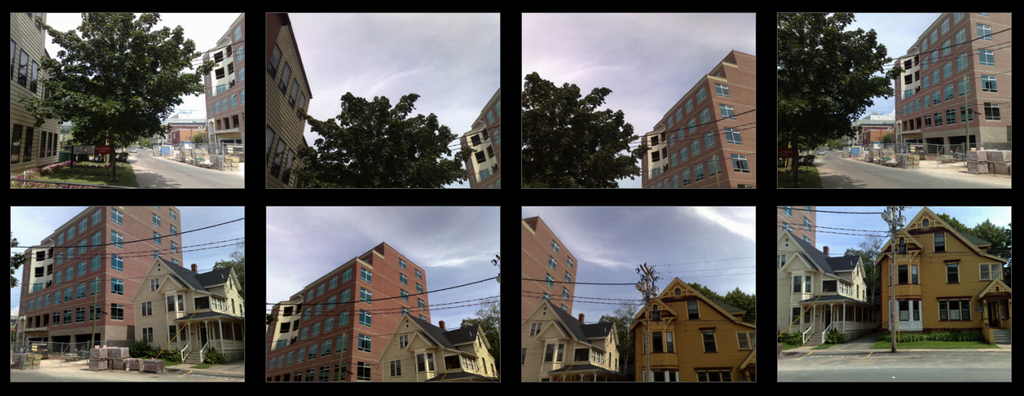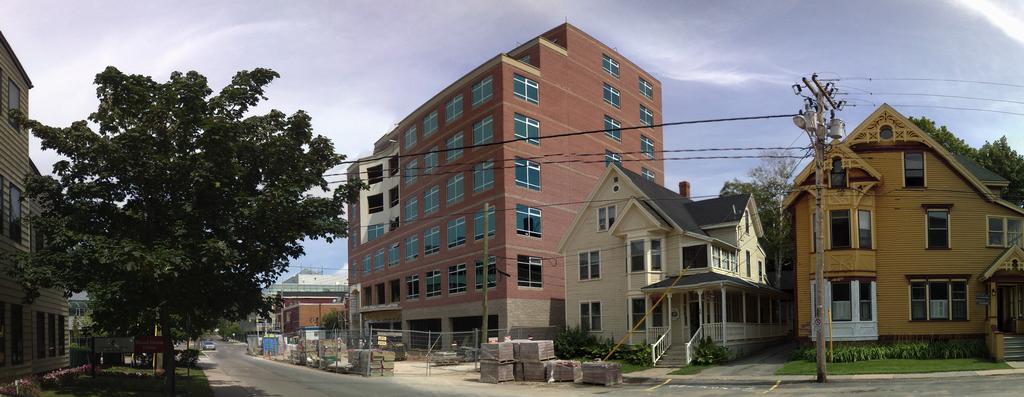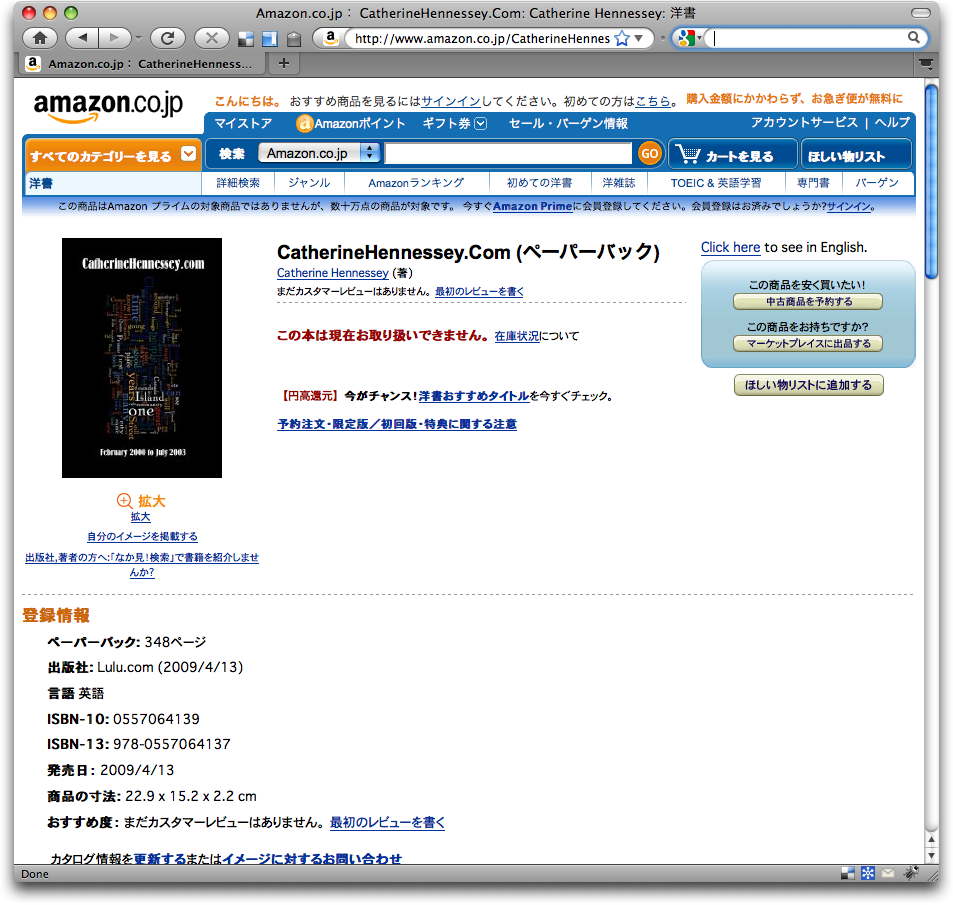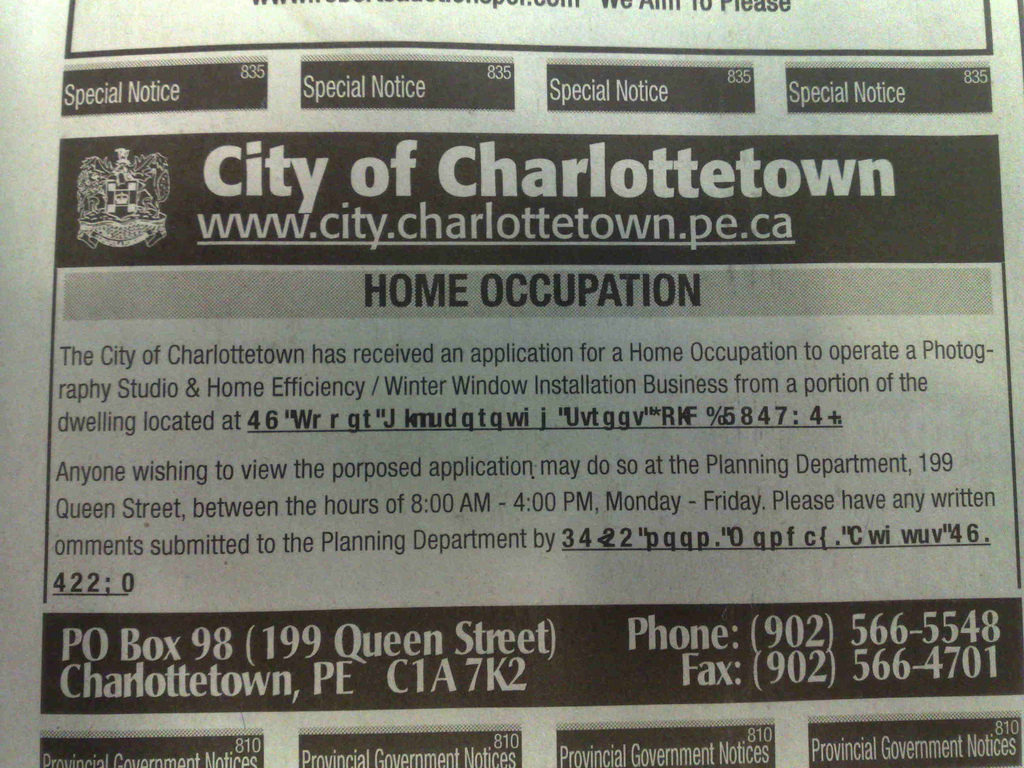There is a well-worn story in the Rukavina-Miller canon that goes like this: back when Catherine and I first moved to Prince Edward Island we were running short of money one week, and didn’t really have enough to scratch together for groceries. On a lark we went out to the Charlottetown Driving Park with our last $10 and tried our hardest to pick the horses that might win us our fortune. Following Catherine’s grandfather’s rule, or at least the rule he enforced while Catherine was around, we limited ourselves to $2 wagers. But then a certain long-odds horse caught our eye, and we went all out and wagered $4. The horse won, and we walked away $40 richer, enough to fill the cupboard and take us out to Swiss Chalet to boot.
Back in the early 1990s, the Driving Park seemed like a sort of time capsule of old Prince Edward Island. Before it got all tarted up and casinoized it was a mildly rough-and-ready kind of place full of well-worm old-timers watching the races from their Impalas. It was a good place for two new Islanders, wet behind the ears and in our late 20s, to get a sense of what Prince Edward Island’s old heart might look like. And so we went almost every week. We rarely wagered more than $10 total in a night, and we never bettered our $40 grocery win, but it was always a fun night.
Then, five years ago, things changed. Suddenly the Driving Park was the Driving Park and Entertainment Centre, with a big addition, a new grandstand, and rumours of chocolate fountains and blackjack tables. Longtime readers will recall that I did not greet this change with open arms and I’ve not been able to bring myself to go back to the track in the interim for fear of sullying myself with all the gold lamé, hookers, and free-flowing whisky.
But then last night I realized that Old Home Week was drawing to a close and in a strange triangulation managed to convince myself that a night at the track might somehow be turned into a teachable math moment for Oliver. So we hitched a ride with Jodi out Kensington Road, paid our $12 to get in the gate, and waded through the chaos of the midway toward the track.
We bought a $2 race program — still a miracle of compact information-rich design — and I spent 15 minutes trying to explain to Oliver how to make sense of it. We watched a race or two and then it was time to wager. Oliver liked the name “Play On” (name-appreciation is the only father-to-son horse-picking wisdom I could pass on), and I liked the name “E.F. Quicky” (how can you go wrong with a horse that has “quick” right in its name) and so we placed a $2 wager on each horse to show, trading maximal payout for maximal chance of the thrill of at-least-partial victory.
To our surprise and delight, the horses finished first and second (E.F. Quicky, of course, came first) and we turned our original $4.00 into $4.50 (wagering “to show” you’re betting that the chosen horse will place first, second or third, so the payouts are not great).
And so when Oliver is sprawled in a gutter in suburban Tampa at age 32 with a tattered racing form tucked in his back pocket and Johnny Walker dribbling out of his ears (yes, I cannot write hard-scrabble very well, given my limited life experience), he will be able to trace his gambling-laced lifestyle back to last night’s first taste of the life.
You know what, though: if you stay outside of the grandstand, with its “Cubano” sandwiches, club chairs and plasma screens beaming in races from Monaco, and just hang out track-side, you can still get a taste of the old heart of Prince Edward Island.
They don’t let Impalas in any more, and you have to put up with “audiotainment” over the PA. But when post time comes the crackle is still there, and you can get a sense, if only thrice-removed, of why so many Islanders are so passionate about the sport to effectively sell their souls to the devil to try to ensure its survival.
Can you help me identify the fiddle instrumental that ran over the closing credits of this week’s episode of Mad Men?
I stumbled across Hugin, an open source photo stitching application, after hearing about OpenStreetView in a podcast interview with Steve Coast.
I’ve been interested in panoramic photo stitching since we first experimented it for these Quicktime VR panoramas of Green Gables back in 1997 (interesting side-story: those panos were used to help investigate the fire at Green Gables that happened only weeks after the original photos were taken).
The state of the art has come a long way since the clunky old (but still somewhat amazing) Quicktime VR authoring tools, and Hugin is a great example of this. After installing it, I dashed out the front door of the office and snapped 8 photos of the new Homburg Skyscraper:

Ten minutes later I had this:

In conjunction with the aforementioned DodoLab event in Charlottetown next week, I’m instigating an OpenStreetMap mapping party on Wednesday, August 26, 2009 from 6:00 p.m. to 10:00 p.m.
Anyone who is interesting in learning how to make maps is welcome to attend. You don’t need to know anything as we can walk you through everything you need to know, and partner up new learners with seasoned map-making veterans. There’s no age limit and it’s all free.
The modest goal for this first Charlottetown OpenStreetMap event is to map the Experimental Farm and neighbouring areas, so we’ll meet at 6:00 p.m. at the Charlottetown Farmer’s Market and use that as our base of operations.
We’ll start with some basic training, and then split up into squads and head out on foot, on bicycle, by car, or otherwise into the area in and around the farm to gather GPS traces for a few hours. We’ll then reconvene to upload the map data to OpenStreetMap and then work on the process of editing the map itself with what we’ve gathered.
Official event details are on the OpenStreetMap wiki. You can RSVP to me by email if you plan to attend.
Things that would be helpful to make the event a success:
- if you’ve used OpenStreetMap before, your expertise would be welcome to show the way for others.
- we need GPS receivers, standalone or built into mobile phones; if you have one or more, please bring them along.
If you want a little more background on the OpenStreetMap project, this podcast is a good place to start.
This promises to be lots of fun.
I have a soft spot in my heart for Shauna McCabe and her wordy crew of cultural warriors (see also Contemporary Psychogeographies).
I don’t understand most of what they write — I’m certain it’s brilliant, but the language is simply too dense for me to casually parse (where they say “experimental co-creative lab for engaging with communities” I might say, for example, “neighbourhood party”).
Verbiage aside (and, heck, I’ve been known to engage is verbiage-play myself), I find the undercarriage of their activities to overlap a lot with stuff that fascinates me. And so I’m kind of excited about DodoLab Charlottetown even though I quite haven’t figured out what it actually is yet. Here’s Shauna’s description of it:
DodoLab Charlottetown has been commissioned by the Confederation Centre. This iteration will include a full week of creative field research and three days of public activity involving a diverse team of students and professionals. Inspired by the Experimental Farm, this DodoLab has been designed to engage with a variety of issues including evolving ideas about farming and agriculture, public and common space, guerrilla and urban gardening and concepts of what is “green,” sustainable and “natural”. DodoLab will engage the public in playful creative exercises in order to investigate, document, and share ideas inspired by a particular local situation that has deep relevance nationally and internationally. Findings from this community-based project will be published on line and presented in the fall.
I think that means “cool people from away hanging out in Charlottetown for a week doing cool stuff.” I believe chickens may be involved, but I’m not sure.
In any case, the Dodoids want your help even before the party gets started. They seek answers to the following:
- What do you remember that is no longer here?
- What would you bring back?
You can email your responses to dodolab@gmail.com (you might post them here too, as I’d be interested to read what you have to say). If you want to follow along more closely, www.dodolab.ca seems like the place to be.
There’s an article in yesterday’s New York Times about buying real estate on Prince Edward Island (pointer from Joel Ives) that reads, in part (emphasis mine):
People from outside Prince Edward Island who wish to buy more than five acres of land or 165 feet of waterfront must apply for permission from the government. The process is largely a formality, said Mr. Poczynek, who noted that there was a “multiplying” effect for the number of names on the deed. (For example, a married couple can buy 10 acres or 330 feet of waterfront without permission.) “Unless you’re going out and buying thousands of acres,” he said, “you’re not going to have an issue.”
Perhaps this “multiplying effect” is common knowledge, but it came as news to me. Surely all any waterfront-land-speculating non-resident need do is get their 9 children on the deed and the effect of the cabinet approval becomes completely moot. Heck, invite the whole neighbourhood to a deed party and you could own half the Island.
Why is this condition there at all? This excerpt from a 1997 presentation to the Standing Committee on the Constitution explains it well:
All Islanders are familiar — perhaps too familiar — with the term, the Island Way of Life. Now this phrase is vague and perhaps not all that useful; but if Islanders were pressed to define it, most would equate it in some way with our rural heritage, our landscape, and our tradition of small, freehold farmsteads. In other words, we define ourselves in relation to the land. And, as a result, we see the disposition of our land — who can own it and how it is used — as central to our existence as a province and a people.
Thus it is no accident that our legislation limiting non-resident ownership — from both outside and, more significantly, within Canada — is unique among the provinces. Nor should it come as a surprise that Island politicians have fought tooth and nail to keep the clause “enjoyment of property” out of Section 7 of the Canada Act of l982; for if it were included, our legislation could scarcely hope to stand challenge in the courts. In fact, at one critical Federal-Provincial meeting, Premier Angus MacLean explicitly sought, and received, support from the separatist René Levesque on this very point.
It’s a shame that something purportedly “central to our existence as a province and a people” has been reduced to “largely a formality.”
Every once in a while something happens on the web that boggles my mind. Today is was stumbling across the CatherineHennessey.com book for sale on Amazon.co.jp in Japan. So, an unlikely project that started as a blog almost ten years ago became a print-on-demand book a year ago and is now on sale in Japan. And I never had to leave my office.
I’ve you’d like to buy a copy for yourself and don’t read Japanese, you can buy one from Amazon.com, or maybe from Amazon.de.

Today was the day for Nigwek, a “street festival for an organic PEI,” held along Victoria Row in downtown Charlottetown.
I went down for lunch, had a very nice bowl of noodles, an Island-grown fruit cup (grapes, gooseberries, raspberries) and a glass of fresh lemonade that was everything a glass of fresh lemonade prepared by a chef dressed in whites should be. While I was enjoying my food I also got to listen to a little Meaghan Blanchard and a little Lorne Elliott. The weather was sunny and warm, friends were plentiful, and it was a nice way to spend a bit of a Sunday afternoon.
But here’s the thing: organic agriculture on Prince Edward Island needs a street festival with a weird name and a bunch of burlap-wearing hippies like it needs a hole in the head.
Don’t get me wrong: I love street festivals, I love weird names, and I love burlap-wearing hippies.
But Nigwek, it says, was organized as “a public exhibition for increased attention toward the necessity of PEI becoming more organic.”
And while Nigwek may have been a fun social event for the “organic community,” by closely adhering to the early-adopter back-to-the-land aesthetic that first gave rise to the organic movement (see also brown rice, Birkenstocks, face painting, alfalfa sprouts, juggling, tofu, et al), Nigwek wasn’t very successful at helping to direct attention at the organic issue outside the community of people who already know that it’s in our collective best interest to move the agricultural economy in this direction.
There are many things standing in the way of a more organic Island; one of the foremost is the perception that growing and eating organic is a fringe movement, fine for vegetarians and people who drive Subarus, but far outside the everyday realm of the average Islander.
If anything, an event aimed at drawing “increased attention toward the necessity of PEI becoming more organic” should be bending over backwards to make organics appear like the most regular everyday thing in the world.
Which is to say that the downtown location, the plaintive folksingers and the weird noodles have gotta go.
Do it in the Walmart parking lot. Or in the empty lots beside McDonald’s. Serve regular everyday food that happens to be organic. And for heaven’s sake, give it a name that doesn’t scream “poetic.” Sell the organic idea on its merits, divorced from a lifestyle that, however attractive it may be to you and me, is just plain weird to everyone else.
There’s a strong and lively cultural aspect to the community that’s embraced an organic lifestyle to this point, and I’ve no issue with that being celebrated and strengthened. But it’s limiting to think that to achieve widespread organic food adoption is going to involve (or requires) a parallel widespread organic culture adoption.
It’s time to bring organics out of the yurt and into the bungalow.

 I am
I am